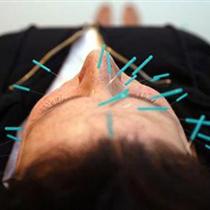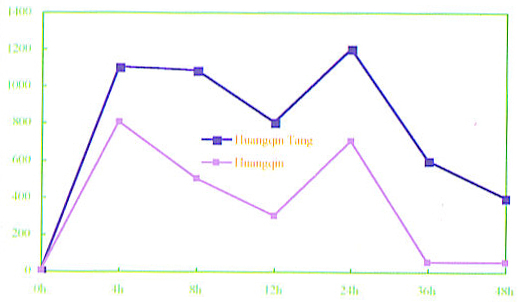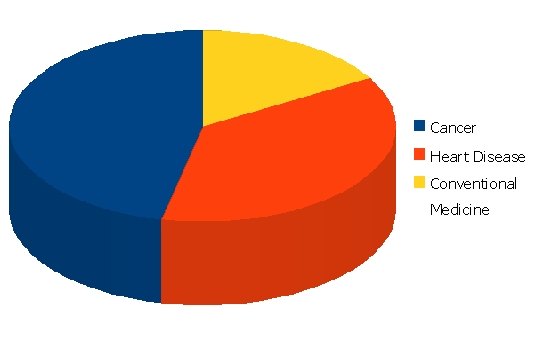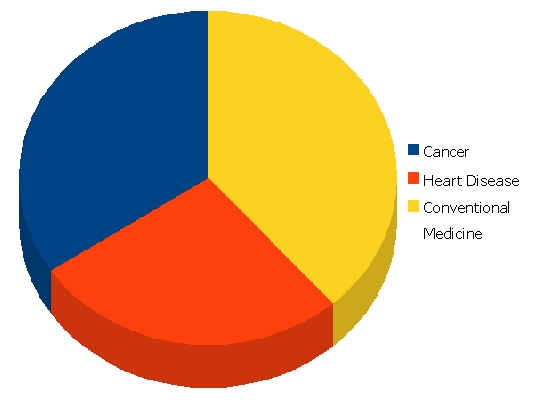The Middle Way
September 22, 2008 at 4:47 pm | Posted in Chinese Medicine | 2 CommentsZhong-Yi. “Middle-Medicine”. This is the doctrine of Balance: Moderation in all things – even moderation.
Zhong-Yi, “Middle-Medicine”, also known as Chinese Medicine, is based on this founding principle of balance. How to maintain it, and how to regain it.
It was decided, as a profession, ages ago, that extreme conditions were inherently unstable and unsafe, and that, for these reasons, these situations were to be avoided whenever possible. This meant a focus on preventative care – the maintenance and potentiation of health.
It was understood that, for balance to be maintained, there was a price to be paid, on a daily basis. A price, fee, or tax, that – over the years – amounted to a healthy balanced body. Or a weakened and diseased one.
The old Tai Chi (and Chinese Medical) axiom “four ounces to move a thousand pounds” captures the essence of this process. A small force, applied consistently at the correct point, can shift huge masses in our favour – or against us.
Like anything else in life, all of this is a skill that must be learned, practiced and perfected.
* The most recent Blog posts will always begin below this first introduction *
What it takes
June 8, 2015 at 4:08 pm | Posted in Uncategorized | Leave a commentLet’s talk about what it takes.
It takes
Kung fu
Effort over time
That’s it, sorry.
Ancient methods lead to more effective malaria medicines
September 14, 2010 at 3:54 pm | Posted in BioMedicine, Chinese Medicine, Herbal Medicine, Modern Research | Leave a commentAncient Chinese preparation methods, that involved either soaking and wringing, or pounding and squeezing the fresh herb Qing Hao (Artemesiae Annuaeare Herba) are more effective than the current method of preparing herbal teas from the dried herb for producing artemisinin-rich extracts. While both extracts exhibited potent in vitro activities against the malaria parasite Plasmodium falciparum, only the pounded juice contained sufficient artemisinin to suppress parasitaemia in vivo. (Ancient Chinese methods are remarkably effective for the preparation of artemisinin-rich extracts of Qing Hao with potent antimalarial activity. Molecules. 2010 Feb 4;15(2):804-12).
Wood Element / Liver Energy / Spring Season: healthy manifestation
May 7, 2010 at 6:55 am | Posted in Chinese Medicine | Leave a commentThis picture is pregnant with possibilities for discussion. For now, consider this: the spectrum on which anger and depression can be found is called the Liver Axis in Chinese Medicine and the photograph above is of anger. How often, in our modern culture, do we see anger as a positive, non-destructive force? Yes, it can be said that this seedling is destroying the asphalt, but how much do we care about the dead asphalt of our lives anyway? Is destroying asphalt actually destruction?
Let yourself marinate in that for a bit…
Too busy for your health? Well…
May 4, 2010 at 3:56 pm | Posted in Uncategorized | Leave a comment“A man too busy to take care of his health is like a mechanic too busy to take care of his tools.”
– Spanish proverb
Herbal Prednisone / Anti-Rheumatic
December 30, 2009 at 5:32 pm | Posted in BioMedicine, Herbal Medicine, Modern Research | 1 CommentTags: BioMedicine, Herbal Medicine, Lei Gong Teng, prednisone, Rheumatoid Arthritis, TwHF
Tripterygium Wilfordii / Lei Gong Teng has received a lot of attention lately, most recently being shown to be a more potent medication than Sulfasalazine for the treatment of Rheumatoid Arthritis.
In the August 2009 issue of the Annals of Internal Medicine, Lei Gong Teng (LGT) was reported to have a large efficacy above and beyond that of Sulfasalazine – at 24 weeks 65% of the Lei Gong Teng group passed the ACR20 criteria, whereas only 33% of the Sulfasalazine group passed the ACR20 criteria.
Corny Buddhist Joke
December 21, 2009 at 6:50 pm | Posted in Uncategorized | Leave a commentIt’s all fun
and games
until someone loses an I
Iatrogenic Disease, Part II
December 16, 2009 at 7:36 pm | Posted in Uncategorized | Leave a comment(This post is under construction.)
A while back I posted on the topic of “Iatrogenic Disease”, meaning, medically-caused disease. The post is here. I had a visitor comment on it and we had a back and forth. In my best judgement, this visitor did not understand the points made, although I do admit that a big gulf lies betwixt us. A portion of his comment follows:
The article [Incidence of Adverse Drug Reactions in Hospitalized Patients. Lazarou, Pomeranz, Corey 1998] does expose adverse drug reactions (in patients in 1994!) as a “serious clinical issue”. Do you think that clinical practice might have evolved a little since then? Maybe as a result of the self-criticism by “conventional medicine” practitioners of which this article is a fine example? Try to absorb this point: this very self-correction, based on science, is what distinguishes “conventional” medicine from “alternative” medicine, and is why the former works and the latter, for the most part, is not effective, as it retains its basis in superstition and wishful thinking.
This poster, like so many of us, does not review his information carefully. Not only did the authors of the study carefully describe their data, including what period of time their data reflects (20 years!), but also what their predictions beyond the data are.
After the above study, the IOM released its information in 1999, which reiterated the size of the problem.
A further study (Zhan, Miller 2003) supports the IOM’s findings.
The most recent study (although it is privately funded) shows a bigger problem.
This most recent study was carried out by a private company which is well-known and used as a resource for insurance and medicare in the u.s.: HealthGrades.
I been Watchin’ U
December 11, 2009 at 5:05 pm | Posted in BioMedicine, Case Management, Herbal Medicine | Leave a commentTags: collaboration, Herbal Medicine, Iatrogenic Disease, prednisone
…Watchin’ me
…via the stat tools in wordpress. Many of the visitors to the site either arrive here via a search term something like this: “herbal prednisone” and are directed to the one post on prednisone and herbs I have. Even many of you who arrive with a different search term end up reading that article anyway.
You people are very interested in prednisone, and for good reason. Prednisone is a lifesaver, and incredibly dangerous too. Who wants to be on that for any significant amount of time once it has done its job?
Due to intense demand, I will be writing a lot more on prednisone.
For now, I will briefly state that the treatment of certain diseases requires the use of prednisone, and the role of CM is to help you extract the maximum benefit from prednisone at the lowest dose for the shortest possible treatment duration.
Two main aspects regarding the case management of cases requiring prednisone:
With CM support:
1. Satisfactory effect from prednisone can be achieved with what some may even consider sub-clinical dosing.
2. The number and severity of flare-ups (which require an increase in the dose of prednisone) can be reduced to a minimum or eliminated.
Keep your eyes open for more posts on this topic!
Sugar Proven Addiction
December 31, 2008 at 6:33 pm | Posted in BioMedicine, Modern Research | Leave a commentTags: Bias, Diabetes, perception, Sugar
From: http://tinyurl.com/a3bbja
It would be so nice to read a headline on a study like this that goes, “Scientists confirm what we all knew”. It would lead to such a different perception of the process.
As it stands, it seems to me that we give up our self-awareness to studies like this, simply by accepting that this kind of research “needs” to be done.
In all honesty, anyone with a smidgen of self-awareness knows that a human being can become addicted to anything.
Sugar? Well, absolutely.
So what’s the research for?
To find what particular pathways are affected.
To what end?
To help people come off their addiction. Ok, stop. Is sugar addiction really that strong? Are we so weak that we can no longer fight against pasta, bread, glucose-supplemented fruit juices and chocolate? There seems to be a slippery slope here somewhere… I am sure that someone, somewhere, has commented on the medicalisation of the human condition – “Why you’ve been hopelessly afflicted with the Human Condition? Egads, good thing we have a drug for that. Several actually…take a seat – they’re still experimental… but you’ll be helping us clear the path… good man”.
Maybe the benefits are in the spin-off research – if we study the pathways of sugar addiction we’ll find the cure to alzheimers. Or an anti-diabetes drug (or the solution for global warming!). All well and good when we put it that way…but isn’t a major issue for most diabetics “managing” sugar effectively? See my diabetes post for a discussion on this topic.
In any case, the idea is regarding the usefulness of research – something that is greatly critiqued in the bioethics community:
This is […] to note that much of the scientific literature – perhaps especially the biomedical literature – is as much about waving arms as it is about communicating results. This is a vulgar glut that pollutes the scientific corpus. (Goodman 2003)
I hope that the next time we see a research article that seems to proclaim a re-invention of the wheel, we will stop and realise that in science, like in any other profession, there are factors at play which are very human in nature. See if the article says something really useful, and otherwise maintain a healthy skepticism – which, by the way, does not take a particular stance, other than to question until clarity occurs.
Bubonic Plague
December 20, 2008 at 12:46 am | Posted in History Lesson | Leave a commentTags: History
During the last years of the Qing Dynasty (around 1900), the bubonic plague swept through Hong Kong, then a British colony. British administrators divided patients into two groups, one of which was treated by Chinese medicine and the other by Western medicine, and evaluated the efficacy of each treatment. The first evaluation indicated that Chinese medicine was 50% more effective than Western medicine. Western doctors in Hong Kong challenged this evaluation and demanded a second evaluation with re-designed parameters. However, the second evaluation also showed that Chinese medicine was effective in 60% of the cases while Western medicine was effective in only 30% of the cases. As a result of this experiment the practice of Chinese medicine was officially allowed in Hong Kong. This historical case is recorded in a well known Chinese medicine book, Yi Xue Zhong Zhong Can Xi Lu (Modifying Chinese and Introducing Western Medicine, Zhang Xi-chun, 1935, reprint 1985, China).
Wow, that’s a lot of needles.
December 11, 2008 at 6:53 pm | Posted in Acupuncture | Leave a commentTags: Acupuncture

Lots of Needles
“The skilled physician uses 1 to 3 needles”
– Chinese Proverb
Season influences Asthma
December 11, 2008 at 3:07 pm | Posted in Uncategorized | Leave a commentIn Chinese Medicine, the Lungs are most vulnerable during the Autumn season, and breathing disorders, such as those described by the western medical term “Asthma”, are commonly seen during that time.
The following is from the New York Times (read the article here):
How, when and where a child is born may all play a role in lifetime asthma risk, new studies suggest.
Asthma occurs when airways in the lungs spasm and swell, restricting the supply of oxygen. The incidence of asthma in the United States has risen steadily for more than two decades, and about 6 percent of children now have asthma, up from less than 4 percent in 1980, according to the Centers for Disease Control and Prevention.
The reasons for the increase are not entirely clear. Genetics probably plays a role in the risk for asthma, but an array of environmental factors — pollen, dust, animal dander, mold, cockroach feces, cigarettes, air pollution, viruses and cold air — have all been implicated in its development.
This month, The American Journal of Respiratory and Critical Care Medicine is reporting that children born in the fall have a 30 percent higher risk for asthma than those born in other seasons. The finding is based on a review of birth and medical records of over 95,000 children in Tennessee.
There is a Rhyme and a Reason
December 8, 2008 at 12:54 am | Posted in Chinese Medicine, Herbal Medicine, Modern Research, Science | Leave a commentTags: Chinese Medicine, Herbal Medicine, jargon, Skepticism, Theory
While I don’t like to go on about reductionism and its assumed evils and so forth, there are grains of truth in these criticisms.
There is a difference between a complex, open (interconnected) system and a small, (relatively) closed system – the former is like the weather, and the latter is like a motor vehicle. I believe we are all familiar with the viscissitudes of weather forecasting, and yet, on the other hand, how generally reliable and unperplexing our vehicles are.
In essence, the first system cannot be reduced without losing its essential complexity and interrelatedness, while the second one can (for a deeper discussion on the relative aspects of this idea, click here). This means that in order to understand a complex, open system, it must be met in its arena of effect. Reducing the arena changes the game and damages the data irretrievably.
In a previous post (Herb Comparable to Prednisone), I wrote about how the oversimplification of Chinese Medical principles tended to damage the effectiveness of the intervention, sometimes completely, and how it was important to understand that in Chinese Medicine we do things for a reason.
More careful research can illuminate some of these reasons, and I would like to provide you with a brief glimpse into one of these investigations:
Chinese Medicine almost always uses herbal combinations rather than single herbs, not only because a single herb has a weak effect, but because herbs can act in synergistic or antagonistic ways to each other (amongst other effects). Thus a properly constructed formula with the individual patient in mind provides a superior effect than the administration of a single herb, or of a non-individualised formula.
The following graph from the Biological and Pharmaceutical Bulletin (2003;26(7):911-919) dramatically illustrates this phenomenon:

The blood concentration of wagonoside from HuangQinTang was twice as high as that of HuangQin alone.
HuangQin Tang is a Chinese Herbal Combination, Huang Qin is merely the lead herb.
HuangQin Tang contains: huáng qín, huáng lián, gé gēn, and zhì gān cǎo.
This type of investigation makes two points:
1. There is a reason that herbal combinations are the standard of care in CM.
2. Deconstructing an open, complex system is fraught with dangers if the aim is to illuminate the true mechanisms or energetic dynamics of said system.
In the western world, and even the eastern world, too much effort has been spent on “identifying” the one herb in a formula which provides the effect, and then further “isolating” “active ingredients” in order to provide the end-user with a “real” medicinal in a “more potent” form for, ostensibly, superior clinical effect.
It’s as if a scientist wanted to provide us with a better vehicle, and decided the active ingredient was the piston, made us a big giant piston to use and acted all proud.
It is my hope that our understanding of the ancient and wise medical systems of this world becomes much more mature in the next short little while.
Incidentally, HuangQin Tang is primarily used for something called “Damp-Heat in the Lower Burner”, one manifestation of which is dysentery. Years ago, a chemical called “berberine” was isolated from another herb in this formula, huáng lián, and used in cases of dysentery. And yes, you guessed it, it doesn’t work as well as HuangQin Tang for the indicated condition.
Oh well.
Do Breast Tumours Go Away On Their Own?
November 25, 2008 at 7:26 pm | Posted in BioMedicine, Modern Health-Care, Modern Research | Leave a commentTags: Anomalous Data Point, Fear, RCT
The Archives of Internal Medicine published an article this week which challenges the conventional wisdom regarding the early detection of breast cancer.
This bit of research is an excellent example of what RCTs are good for: examination of apparently homogeneous populations to find indications of non-homogeneity.
Two groups were studied – women with frequent screening (and their cancer rates), and women with infrequent screening (and their cancer rates). The researchers were astounded to discover that, in these two large groups of people (approx 100,000 each), there was a twenty two percent greater incidence of cancer in the women who were screened frequently[1].
There are many explanations for this phenomena – the one that the authors advance is that a certain proportion of tumors go away “on their own” (although this author is certain it is not quite that random or mysterious).
If we read the USA Today article, we can find an interesting statement by the cancer society’s Robert Smith: “It’s important that people not wonder if women lost their breasts for no reason. That’s a reprehensible conjecture.”
Mr. Smith, medicine is not about feel-good. It’s about finding the correct way to maintain health and the correct way to resolve disease. Avoiding a conjecture because of a bad feeling is bad medicine. Conjectures should be based on the best available data and followed accordingly.
And, yes, unfortunately, human life does seem to have quite a bit of uncertainty and ignorance built-in.
From the study:
Conclusions Because the cumulative incidence among controls never reached that of the screened group, it appears that some breast cancers detected by repeated mammographic screening would not persist to be detectable by a single mammogram at the end of 6 years. This raises the possibility that the natural course of some screen-detected invasive breast cancers is to spontaneously regress.
Why the fear that cancer can be cured? Why not just write that the evidence indicates that the body is able to heal some cancers on its own some of the time?
The fear, in this case, doesn’t help us.
There is another possibility, which is the one that the spokesman for the cancer society immediately assailed: is it possible that the search and treatment for cancer causes more cancer?
It would seem that, if this is the case, the fear definitely doesn’t help us.
1.The natural history of invasive breast cancers detected by screening mammography. Arch Intern Med. 2008 Nov 24;168(21):2302-3.
Create a free website or blog at WordPress.com.
Entries and comments feeds.



